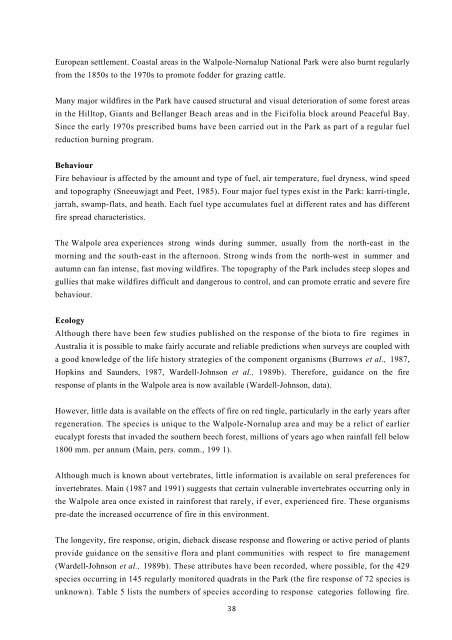Walpole-Nornalup National Park - Department of Environment and ...
Walpole-Nornalup National Park - Department of Environment and ...
Walpole-Nornalup National Park - Department of Environment and ...
You also want an ePaper? Increase the reach of your titles
YUMPU automatically turns print PDFs into web optimized ePapers that Google loves.
European settlement. Coastal areas in the <strong>Walpole</strong>-<strong>Nornalup</strong> <strong>National</strong> <strong>Park</strong> were also burnt regularly<br />
from the 1850s to the 1970s to promote fodder for grazing cattle.<br />
Many major wildfires in the <strong>Park</strong> have caused structural <strong>and</strong> visual deterioration <strong>of</strong> some forest areas<br />
in the Hilltop, Giants <strong>and</strong> Bellanger Beach areas <strong>and</strong> in the Ficifolia block around Peaceful Bay.<br />
Since the early 1970s prescribed bums have been carried out in the <strong>Park</strong> as part <strong>of</strong> a regular fuel<br />
reduction burning program.<br />
Behaviour<br />
Fire behaviour is affected by the amount <strong>and</strong> type <strong>of</strong> fuel, air temperature, fuel dryness, wind speed<br />
<strong>and</strong> topography (Sneeuwjagt <strong>and</strong> Peet, 1985). Four major fuel types exist in the <strong>Park</strong>: karri-tingle,<br />
jarrah, swamp-flats, <strong>and</strong> heath. Each fuel type accumulates fuel at different rates <strong>and</strong> has different<br />
fire spread characteristics.<br />
The <strong>Walpole</strong> area experiences strong winds during summer, usually from the north-east in the<br />
morning <strong>and</strong> the south-east in the afternoon. Strong winds from the north-west in summer <strong>and</strong><br />
autumn can fan intense, fast moving wildfires. The topography <strong>of</strong> the <strong>Park</strong> includes steep slopes <strong>and</strong><br />
gullies that make wildfires difficult <strong>and</strong> dangerous to control, <strong>and</strong> can promote erratic <strong>and</strong> severe fire<br />
behaviour.<br />
Ecology<br />
Although there have been few studies published on the response <strong>of</strong> the biota to fire regimes in<br />
Australia it is possible to make fairly accurate <strong>and</strong> reliable predictions when surveys are coupled with<br />
a good knowledge <strong>of</strong> the life history strategies <strong>of</strong> the component organisms (Burrows et al., 1987,<br />
Hopkins <strong>and</strong> Saunders, 1987, Wardell-Johnson et al., 1989b). Therefore, guidance on the fire<br />
response <strong>of</strong> plants in the <strong>Walpole</strong> area is now available (Wardell-Johnson, data).<br />
However, little data is available on the effects <strong>of</strong> fire on red tingle, particularly in the early years after<br />
regeneration. The species is unique to the <strong>Walpole</strong>-<strong>Nornalup</strong> area <strong>and</strong> may be a relict <strong>of</strong> earlier<br />
eucalypt forests that invaded the southern beech forest, millions <strong>of</strong> years ago when rainfall fell below<br />
1800 mm. per annum (Main, pers. comm., 199 1).<br />
Although much is known about vertebrates, little information is available on seral preferences for<br />
invertebrates. Main (1987 <strong>and</strong> 1991) suggests that certain vulnerable invertebrates occurring only in<br />
the <strong>Walpole</strong> area once existed in rainforest that rarely, if ever, experienced fire. These organisms<br />
pre-date the increased occurrence <strong>of</strong> fire in this environment.<br />
The longevity, fire response, origin, dieback disease response <strong>and</strong> flowering or active period <strong>of</strong> plants<br />
provide guidance on the sensitive flora <strong>and</strong> plant communities with respect to fire management<br />
(Wardell-Johnson et al., 1989b). These attributes have been recorded, where possible, for the 429<br />
species occurring in 145 regularly monitored quadrats in the <strong>Park</strong> (the fire response <strong>of</strong> 72 species is<br />
unknown). Table 5 lists the numbers <strong>of</strong> species according to response categories following fire.<br />
38

















